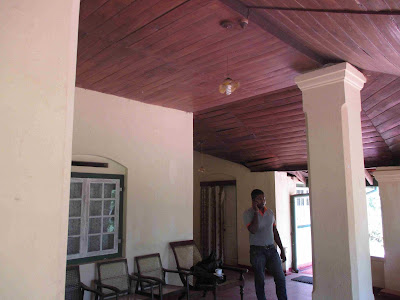Our grandparents, Charles Stanley Braine and Paththinikuttige Engracia Nonis, were married on 14 May 1924. They were married at Bandirippuwa church, in the village adjoining Boralessa, where grandma lived.
They had had their first child, Rosie, in 1909, and went on to have 9 children. My dad Ted, born in 1926, being the last.
Grandmother was from a devout Catholic family. I understand that Catholic priests and nuns brought much pressure on granddad to formalize their relationship. In fact, the two witnesses to the marriage were nuns.
In those days, marriages between Europeans and local women were frowned upon by Europeans, but many European men (especially planters) cohabited with local women and had offspring. Grandad must have faced strong opposition from his brother and two sisters, and even from his mother, who died in 1909, the year Rosie was born.
Because our grandparent's weren't married, the childrens' baptismal certificates (and birth certificates, too, if any existed) would have borne the damning line "Father unknown". Even my dad's baptismal certificate bears the same "Father unknown" although he was born after his parents were married. Someone has been careless.
Grandma's father was Ambrose Nonis and her mother Warnakulasuriya Rosa Maria Fernando. When she met grandpa, grandma already had two daughters, Mary and Julia. Father unknown.
I, the undersigned Missionary Apostolic, do hereby declare and certify that Charles Stanley Braine, son of Charles Frederic Braine and of Adeline Mary Becher of the village of Mawatte Estate, Haldanduwana and Paththinikuttige Engracia Nonis daughter of Paththinikuttige Ambrose Nonis and of Warnakulasuriya Rosa Maria Fernando of the village of Boralessa were duly joined in the bonds of holy matrimony on the 14 day of May 1924 according to the rites of the Holy Catholic Church , in the presence of Rev. Fr. Paul Alles OMI the local missionary , and the two known witnesses Sr. Mary of St. Solange Superior of the Convent of Negombo and Sr. Mary of St. Antony.
As shown by the Register of Marriages of the Archbishops House. Given at Bandirippuwa on the 10th day of June 1924.
In a number of ways, our grandparents' marriage was unusual. They came from very different backgrounds, he from a line of English planters (the English were the colonial rulers of Ceylon, and had immense power and influence), and she from a poor family. In fact, at the time they met, grandmother worked as a labourer at Mawatte Estate, where grandpa was the manager. She did not speak English, and he did not speak Sinhala, grandma's native tongue. But grandpa could speak Tamil, because his labourers were Tamils. Grandma was fluent in Tamil, too. So they spoke to each other in Tamil.
Shipping records show that grandpa made a number of trips to the UK after he began to live with grandma, but he did not take her along. Most probably, he did not take her along when he socialized with fellow English planters, either.
By all accounts, grandad was a loving father. He was affectionate and generous to his large brood. He bought a 50-acre property, which he named "Greenwood", for his children. He also bought or built "Stanlodge", at Lewis Place, Negombo (which is an expensive tourist area now), so that his children could attend nearby schools. Grandma had relatives who lived in the neighborhood. Grandma also bought about 6 acres of land at Boralessa, no doubt with grandpa's support. She distributed these properties among her children, and they all sold them off. I am the last holdout, owning "Pondside", which grandma had given Uncle George. Charles, only child of Marie (Rosie's daughter), also lives on the property which his grandmother Rosie got from grandma.
Grandpa died 6 years before I was born, at the height of World War II. But I remember grandma very well. She lived on for 32 years after he passed away, at "The Meet" in Boralessa, and later with Aunty Rosie and Marie. Despite the numerous tribulations she suffered at the hands of some of her children, she wasn't bitter. She was sweet and affectionate, and often talked about her husband. Her relatives, the Nonises, can still be found in the village. I see them everyday.










